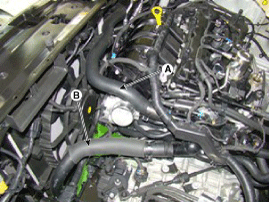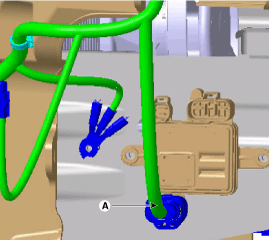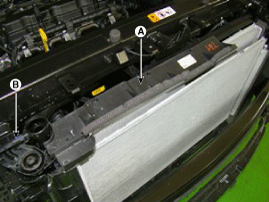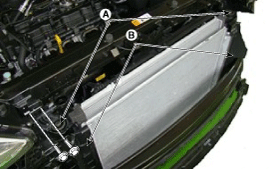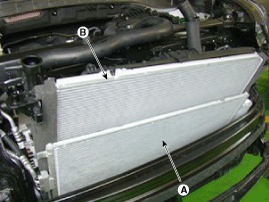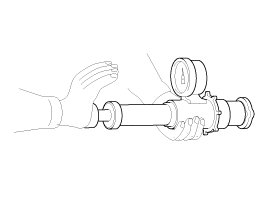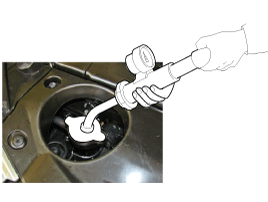 Hyundai Santa Fe: Radiator. Repair procedures
Hyundai Santa Fe: Radiator. Repair procedures
Removal and Installation
| 1. |
Disconnect the battery terminals.
|
| 2. |
Remove the air cleaner assembly.
|
| 3. |
Remove the under cover.
|
| 4. |
Loosen the drain plug, and drain the coolant.
Remove the radiator cap to speed draining.
|
| 5. |
Remove the front bumper.
|
| 6. |
Remove the radiator upper hose (A) and lowr hose
(B).
|
| 7. |
Disconnect the PWM module connector (A).
|
| 8. |
Remove the air intake shield (A).
|
| 9. |
Remove the upper air guard (A) and radiator over
flow hose (B).
|
| 10. |
Remove the horn.
|
| 11. |
Remove the upper bracket (A) and air guard (B).
|
| 12. |
Separate the condenser (A) from the radiator (B)
and then remove the radiator assembly.
|
| 13. |
Install in the reverse order of removal.
|
| 14. |
Fill the radiator with coolant and check for leaks.
|
Inspection
| 1. |
Remove the radiator cap, wet its seal with engine
coolant, and then install it on a pressure tester.
|
| 2. |
Apply a pressure of 79.4 ~ 122.58 kPa (0.95 ~ 1.25
kgf/cm², 11.5 ~ 17.78 psi).
|
| 3. |
Check for a drop in pressure.
|
| 4. |
If the pressure drops, replace the cap.
|
| 1. |
Wait until engine is cool, then carefully remove
the radiator cap and fill the radiator with engine coolant, then install
it on the pressure tester.
|
| 2. |
Apply a pressure tester to the radiator and apply
a pressure of 93.16 ~ 122.58 kPa (0.95 ~ 1.25 kgf/cm², 13.51 ~ 17.78
psi).
|
| 3. |
Inspect for engine coolant leaks and a drop in pressure.
|
| 4. |
Remove the tester and reinstall the radiator cap.
|
 Radiator. Components and Components Location
Radiator. Components and Components Location
Components 1. Radiator 2. Radiator lower hose 3. Radiator upper hose 4. Radiator upper guard 5. Radiator side air gusrd 6. Radiator upper mounting bracket 7. Radiator lower mounting insulator ...
 Cooling Fan. Components and Components Location
Cooling Fan. Components and Components Location
Components 1. Upper air guard 2. PWM module 3. Cooling fan shroud 4. Fan motor 5. Cooling fan ...
See also:
Special Service Tools
Special Service Tools Tool(Number and Name) Illustration Use 09495-33000 Puller Removal of spider assembly from a drive shaft. 09568-4A000 Ball joint puller Remove the ball joint 09495-3K000 Band installer ...
Cowl Cross Bar Assembly. Repair procedures
Replacement • Put on gloves to protect your hands. • When prying with a flat-tip screwdriver, wrap it with protective tape, and apply protective tape around the related parts, to prevent damage. • ...
Driving at night
Because night driving presents more hazards than driving in the daylight, here are some important tips to remember: Slow down and keep more distance between you and other vehicles, as it may be more difficult ...

